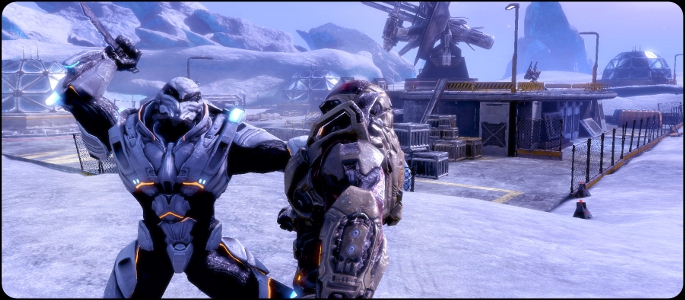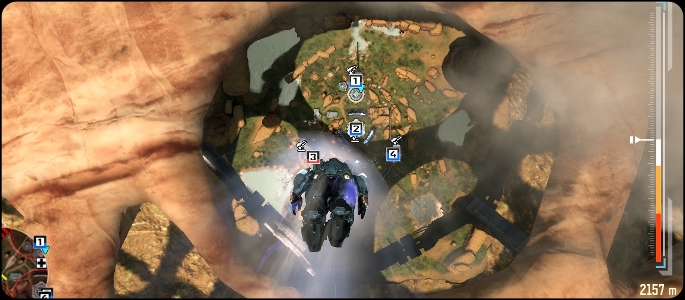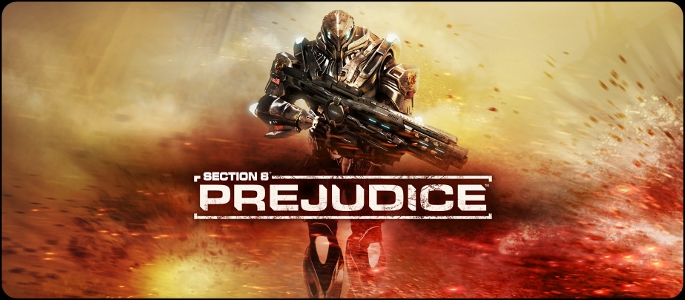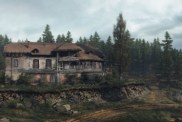Last year’s budget FPS title from TimeGate Studios is back with a digital download-only sequel and a very affordable price point. Of course, it leads one to wonder if Section 8: Prejudice packs enough content and fun to make it stand out in an over-saturated genre.
Similar to the original Section 8, Prejudice is centered around a group of soldiers in the 8th Armored Infantry who wear super suits that grant them special abilities and shielding to use on the battlefield. At a glance it’s obvious that Section 8: Prejudice was built for a multiplayer experience, but a fair-sized single-player component is included which mostly serves as a tutorial for using the numerous weapons, tools, deployable structures, and vehicles found throughout the game.
The storyline starts off shortly after where Section 8 last left us. Players control Alex Corde, a member of Section 8 who has very little depth of character, but enough shooting skills to lead the charge into battle when the Arm of Orion foes make their return. A short initial tutorial introduces us to basic shooting mechanics, including a temporary lock on skill, as well as the always equipped but short-range jetpack. The Overdrive skill also returns, which allows Alex to sprint at superhuman speeds after starting with a short jog.

The roughly five and a half hour long campaign that follows, starts off with a strong enough premise, but quickly dissolves into an objective to objective shooting gallery, which steadily introduces you to new weapons and equipment along the way. It’s revealed early on that the antagonist faction Arm of Orion is in fact the remains of a military genetic experiment who were abandoned, and now have returned for revenge. Frankly, I can’t blame them for being mad, and it sounds like we’re on the wrong side of the fight, but Alex dives in head on, and the story devolves from there into cliché soldier versus madman territory. This, among other qualities, leaves the campaign mode feeling like a tacked on lengthy tutorial, but in that respect it serves its purpose well enough. However, that tacked on feeling continues when you battle the same enemies for the entire ride, with their only real changes involving stronger shields, armor, and a variety of weapons which are also at your own disposal. Eventually you’ll fight off a few mechs too, pilot one of your own, and make use of a well armed tank and fast paced hover bike.
While it’s great that TimeGate Studios has included a substantially sized campaign, the multiplayer is without a doubt the reason to purchase Section 8: Prejudice. It’s here that the large number of loadout options, deployable structures, and vehicles stand out to make the game a fun experience. In any of the four multiplayer game types up to six custom load outs can be created. This allows players to select primary and secondary weapons such as a pistol, shotgun, machine gun, assault rifle, sniper rifle, missile launcher, and plasma gun. Each weapon has multiple ammo types such as rapid fire, incendiary fire, and EMP rounds, providing an incredible number of options for each load out. Two equipment slots let you pick from various grenades, mortars, knives, and repair tools, and class bonuses such as increased shields, armor, repair speed, jetpack recharge rates, can be selected as well. The class bonuses sound like a great idea, especially with bonuses like the Gyro Stabilizer which grants an additional 8% recoil dampening, 6% accuracy, and 2% bullet damage per point invested. Up to four points can be invested in any bonus, with a total of 10 points to distribute in the beginning of the game. Unfortunately, after playing around with various load outs I found it’s hard to notice these bonuses in effect, even though the percentages look great on screen. I’m sure they’re working, but I never felt like my character played differently as a result of them.

As matches are played making kills, taking objectives, healing team mates, and accomplishing just about anything rewards the player with points which accrue as currency. The currency only lasts for the current round, but can be used to call down minigun turrets, missile turrets, AA turrets, supply depots, sensor arrays, and the aforementioned vehicles. Smart use of these can turn the tide of battle, and the AA turrets have an especially noticeable tactical advantage. As players spawn into the map they can choose to spawn on allies or freely pick any location on the map, after which they are ejected from a low orbit ship and plummet to the ground relying on only their supersuit for protection. While you’ll easily survive the landing in possibly the most epic spawn sequence of all time, deploying within range of an AA turret will have you promptly shot out of the sky, making them important for holding your opponents away from critical portions of the map. Since all players, structures, and vehicles arrive via the same means, they are all susceptible to this defense.

This all comes in handy throughout the four online modes available in Section 8: Prejudice, which includes Conquest, Swarm, Skrimish, and Assault. Conquest mode places four controls points on the map, which players fight for control of by hacking terminals and defending the area to gain points. Each control point is linked to a number of permanent structures, usually including an AA turret, supply depot, and sensor array to give a tactical advantage. The structures may be destroyed temporarily but can always be repaired, often times making it a race to destroy the structures, hack the terminal, and then repair them to bring defenses back up.
Swarm mode is a typical cooperative survival mode against wave after wave of enemies, pitting four players in an arena with the task of protecting a terminal from being hacked by the enemies. Deployable structures and vehicles become crucial here for defense, and it makes the mode really fun to coordinate between teammates for who will maintain the turrets and who will hop in vehicles to wreak havoc.
Skirmish mode is basically a team deathmatch mode, but it also includes the Dynamic Combat Missions (DCM) that appear in all other modes. Points can be scored for kills, but many more are scored by completing the random DCM side objectives that pop up through out the round, like retrieving various bits of wreckage scattered on the map, or escorting a VIP player across the map. Successfully completing a DCM rewards plenty of points to that team, but failing also rewards those points to the other team, making them almost as important as main objectives in any mode, but a definite priority during Skirmish.

Assault is similar to Conquest in the respect that it’s about taking over control points. However, a vital difference involves one team playing on defense, and the other on offense. Once the offensive team takes a control point it gets locked in permanently, with the ultimate goal to take all four points, or defend them until time runs out. The defensive team gets a bit of cash and extra starting time to set up preliminary defenses, making the mode slightly more strategic than the others. During that time the offense gets to free roam as invisible cameras, spotting enemy locations and giving a chance to coordinate a plan of attack.
Despite the pseudo-strategic nature of Section 8: Prejudice‘s multiplayer modes, don’t mistake it for a tactical military shooter. With every player having access to jetpacks and the Overdrive ability Prejudice plays like an arcade shooter, and that’s nailed in with the feeling of the weaponry available. While there’s definitely massive differences in power and rate of fire for all the weapons, there is virtually no recoil on most weapons, and incredible accuracy for all of them, turning this into a very run and gun affair. The ability to lock on to moving opponents adds incentive to that style of play, often times turning battles from a test of accurate reflexes to a matter of who can pump more bullets into the other first, and jet packing away as soon as your clip runs out. That’s not necessarily a bad thing, and can in fact be quite fun, but it also makes combat incredibly chaotic and unpredictable. Besides that, for most weapons the customizable ammo sets are either powerful against shields, armor, or vehicles, but generally not both. This generally results in it being necessary to equip a weapon for taking down shields, and another for armor, or simply relying on pumping a lot of bullets into a meaty target before they get you.

Overall, Section 8: Prejudice isn’t doing a lot to make it stand apart from other FPS games, except for the incredible price tag to content ratio. The game mechanics are solidly implemented, online modes are fun, especially with a couple of buddies in Swarm mode, and the servers are running well with few lag issues. Plenty of load out options are packed in with the 6 available multiplayer maps (two of which are DLC for $4 total), and a decent length campaign accompanies it all. While the sub-par campaign should definitely be the last reason to pick up Prejudice, it’s definitely commendable that it sports the length of several recently released AAA shooter games. It even looks good graphically, even if it’s nothing that’ll have you dropping your jaw over, and the decent visuals still make it worthwhile to pick up the controller to blow stuff up. More incredibly affordable DLC map packs are on the way too, for a mere $4 each, easily extending the experience and still staying within a reasonable budget. Any way you spin it, it’s hard to argue with the value here. For what you would spend on one measly map pack in another game you could pick up an entirely new arcade style FPS, with a full campaign and robust multiplayer mode which, simply put, is a fantastic deal.
PlayStation LifeStyle’s Final Score
+ Robust Loadout Selection + Fantastic Content to Price Ratio – Forgettable campaign story |
 |
–






